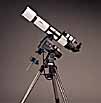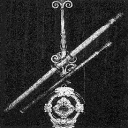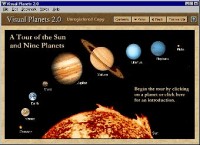


CONTENTS - 1. Essential Astronomy
**Our Solar System
Asteroids
Comets
The Kuiper Belt and the Oort Cloud
What are the Stars?
Celestial Coordinate Systems
Galaxies
Telescopes
**Choosing a Telescope
What time is it?
CONTENTS - 2. Specialized Topics
Cosmology
Dark Matter
Eclipses
The Equation of Time
Gamma-Ray Astronomy
The History of Astronomy
Meridian Astronomy
Meteors and Meteorites
Meteor Showers
Moon Phases
What's New on the Moon?
Aurora Borealis: The Northern Lights
Orbits and Gravitation
Photometry
Pulsars
Getting Started in Radio Astronomy
Relativity
The Sun
Sundials
Terrestrial Impact Craters
The Tides
From our small world we have gazed upon the cosmic ocean for untold thousands of years. Ancient astronomers observed points of light that appeared to move among the stars. They called these objects planets, meaning wanderers. The Romans named them after their deities: Jupiter, king of the gods; Mars, the god of war; Mercury, messenger of the gods; Venus, goddess of love and beauty, and Saturn, father of Jupiter and god of agriculture. These are the names that have stuck, but there were others - the Egyptian and the Babylonian, to name only two sky-fixated cultures.
These ancient stargazers also observed comets with sparkling tails, meteors or shooting stars apparently falling from the sky, and the mysterious constellations that seemed to shape man's very destiny and the fate of civilizations. The dynastic and pre-dynastic Egyptians were already precisely observing the slow precessional drift of the equinoxes over unimaginable spans of eons - Maya, Aztec, and other Central and South American cultures appear to have inherited this extensive body of star-lore intact. The knowledge enabled them to create a type of calendar whose astonishing precision still puts our own Gregorian one to shame.
While Western Europe staggered through a millennium of darkness and barbarism, the Arabs in the 8th and 9th Centuries were already creating an art (if not indeed a science) out of observation and the naming of stars. Much of our modern stellar nomenclature thus has roots in Islamic culture, which gradually percolated northwards and pierced the Middle Ages with a shaft of light.
Science as we know it today, through that re-discovery of Graeco-Egyptian thought transmitted by the Arabs, finally became separated from astrology and came to flower during the European Renaissance. Fundamental physical laws governing planetary motion were (re?)discovered, and the orbits of the planets round the sun were calculated. In the 17th century, astronomers pointed a new device called the telescope at the heavens and made startling discoveries.
But the years since 1959 have amounted to a golden age of solar system exploration. Advancements in rocketry after World War II enabled our machines to break the grip of Earth's gravity and travel to the Moon and to other planets.
The United States has sent automated spacecraft, then human-crewed expeditions, to explore the Moon. Our automated machines have orbited and landed on Venus and Mars; explored the sun's environment; observed comets, and made close-range surveys while flying past Mercury, Jupiter, Saturn, Uranus and Neptune. These travellers brought a quantum leap in our knowledge and understanding of the solar system. Through the electronic sight and other senses of our automated spacecraft, colour and complexion have been given to worlds that for centuries appeared to Earth-bound eyes as fuzzy disks or indistinct points of light. And dozens of previously unknown objects have been discovered. Future historians will likely view these pioneering flights through the solar system as some of the most remarkable achievements of the 20th century.
The National Aeronautics and Space Administration's (NASA's) automated spacecraft for solar system exploration come in many shapes and sizes. While they are designed to fulfil separate and specific mission objectives, the craft share much in common.
Each spacecraft consists of various scientific instruments selected for a particular mission, supported by basic subsystems for electrical power, trajectory and orientation control, as well as for processing data and communicating with Earth. Electrical power is required to operate the spacecraft instruments and systems. NASA uses both solar energy from arrays of photo-voltaic cells and small nuclear generators to power its solar system missions. Rechargeable batteries are employed for backup and supplemental power. Imagine that a spacecraft has successfully journeyed millions of miles through space to fly but one time near a planet, only to have its cameras and other sensing instruments pointed the wrong way as it speeds past the target
To help prevent such a mishap, a subsystem of small thrusters is used to control spacecraft. The thrusters are linked with devices that maintain a constant gaze at selected stars. Just as Earth's early seafarers used the stars to navigate the oceans, spacecraft use stars to maintain their bearings in space. With the sub-system locked onto fixed points of reference, flight controllers can keep a spacecraft's scientific instruments pointed at the target body and the craft's communications antennas pointed toward Earth. The thrusters can also be used to fine-tune the flight path and speed of the spacecraft to ensure that a target body is encountered at the planned distance and on the proper trajectory.
Between 1959 and 1971, NASA spacecraft were dispatched to study the Moon and the solar environment; they also scanned the inner planets other than Earth -- Mercury, Venus and Mars. These three worlds, and our own, are known as the terrestrial planets because they share a solid-rock composition. For the early planetary reconnaissance missions, NASA employed a highly successful series of spacecraft called the Mariners. Their flights helped shape the planning of later missions. Between 1962 and 1975, seven Mariner missions conducted the first surveys of our planetary neighbours in space. All of the Mariners used solar panels as their primary power source. The first and the final versions of the spacecraft had two wings covered with photo-voltaic cells.
Other Mariners were equipped with four solar panels extending from their octagonal bodies. Although the Mariners ranged from the Mariner 2 Venus spacecraft, weighing in at 203 kilograms (447 pounds), to the Mariner 9 Mars Orbiter, weighing in at 974 kilograms (2,147 pounds), their basic design remained quite similar through-out the program. The Mariner 5 Venus spacecraft, for example, had originally been a backup for the Mariner 4 Mars flyby. The Mariner 10 spacecraft sent to Venus and Mercury used components left over from the Mariner 9 Mars Orbiter program.
In 1972, NASA launched Pioneer 10, a Jupiter spacecraft. Interest was shifting to four of the outer planets -- Jupiter, Saturn, Uranus and Neptune -- giant balls of dense gas quite different from the terrestrial worlds we had already surveyed. Four NASA spacecraft in all -- two Pioneers and two Voyagers -- were sent in the 1970s to tour the outer regions of our solar system. Because of the distances involved, these travellers took anywhere from 20 months to 12 years to reach their destinations. Barring faster spacecraft, they will eventually become the first human artefacts to journey to distant stars. Because the sun's light becomes so faint in the outer solar system, these travellers do not use solar power but instead operate on electricity generated by heat from the decay of radioisotopes.
NASA also developed highly specialised spacecraft to revisit our neighbours Mars and Venus in the middle and late 1970s. Twin Viking Landers were equipped to serve as seismic and weather stations and as biology laboratories. Two advanced orbiters -- descendants of the Mariner craft -- carried the Viking Landers from Earth and then studied Martian features from above. Two drum-shaped Pioneer spacecraft visited Venus in 1978. The Pioneer Venus Orbiter was equipped with a radar instrument that allowed it to "see" through the planet's dense cloud cover to study surface features. The Pioneer Venus Multiprobe carried four probes that were dropped through the clouds. The probes and the main body -- all of which contained scientific instruments -- radioed information about the planet's atmosphere during their descent toward the surface. A new generation of automated spacecraft -- including Magellan, Galileo, Ulysses, and Cassini -- is being developed and sent out into the solar system to make detailed examinations that will increase our understanding of our neighbourhood and our own planet.
But where does the beginner in amateur astronomy start? If you are one such, and do not yet own your own telescope, you have probably asked yourself many times whether you really need one - And if you do, which is right for you? Solutions are as various as the human personalities that find them. The good news is that there are broad areas of advice which can and should always be born in mind prior to the acquisition of your first real observing tool.



What an ideal instrument will show you
Reality is humbling: many of these optimistic assertions should be taken with a pinch of salt! And much will depend on the training of the eye itself. As with everything, practice is the key.
| TYPE OF SCOPE | WITHIN THE SOLAR SYSTEM | STARS | DEEP SKY OBJECTS |
| 60mm (2.4") to 70mm (2.75")
refractor, at powers of 25x to 125x (objects within the solar system generally need 60x and up) |
sunspots (with an appropriate solar filter); the phases of Venus; lunar craters as small as four or five miles in diameter; several cloud belts on Jupiter, plus the four Galilean moons; the rings of Saturn (and occasionally Cassini's division, with good seeing); Uranus and Neptune visible as small greenish points | double stars separated by as little as 2 arc seconds; faint stars down to magnitude 11.5 | the larger globular star clusters, some of the brighter nebulae, virtually all of the Messier objects from a dark sky site (although with relatively little detail visible in many of them) |
| 3.1" to 3.5" refractor, or 4" to 4.5" reflector, or 3.5" to 5" catadioptric, at powers of 16x to 250x |
structure in sunspots (with an appropriate solar filter); the phases of Mercury; lunar rilles and craters less than three miles across; Martian polar caps and major dark surface features during oppositions; several additional cloud belts on Jupiter; some detail in the belts and the shadows of Jupiter's moons on the planet during transits; Cassini's division in Saturn's rings on a regular basis, plus four or five of its moons; Uranus and Neptune visible as very small discs | double stars separated by 1.5 arc seconds or less; faint stars to better than magnitude 12 | dozens of globular clusters, emission nebulae, planetary nebulae, and galaxies; all of the Messier objects and many of the brighter NGC objects from a dark sky site (with some internal detail visible in many nebulae, although galaxies will remain relatively featureless hazy patches for the most part) |
| 4" to 5" refractor, or 6" reflector, at powers of 30x to 300x |
domes, rilles, and other lunar features less than two miles across; many more dark surface features on Mars, even during less-than-favorable oppositions; festoons, streamers, and much more detail in Jupiter's cloud belts with good seeing; cloud belts on Saturn's disk; many faint comets and asteroids | double stars separated by about 1 arc second; faint stars down to magnitude 13 or better | hundreds of star clusters, nebulae, and galaxies (spiral structure becoming visible in some galaxies); many, many NGC objects from a dark sky site (considerable detail in nebulae and clusters) |
| 6" to 7" refractor, or 8" reflector, or 7" to 8" catadioptric, at powers of 50x to 400x |
lunar features under one mile across; large clouds and dust storms on Mars; as many as six or seven of Saturn's moons; Jupiter's four Galilean moons start to show as tiny discs; seeing conditions start to limit how much solar system detail you can see on an average night | double stars separated by less than 1 arc second; faint stars down to magnitude 14 | some globulars resolved almost to the core, much internal detail in nebulae and visible structure in many galaxies from a dark sky site |
| 10" and larger reflector, or 10" and larger catadioptric, at powers of 60x to 500x |
given excellent seeing conditions, lunar features to much less than one mile across; small clouds and significant surface detail on Mars, with moons Deimos and Phobos a rare possibility; a wealth of detail in Jupiter's clouds and belts; Enke's division in Saturn's rings; Neptune's moon Triton visible; Pluto visible as faint star-like point; the amount of solar system detail visible will usually be limited by the seeing conditions with large scopes like these, making them less than ideal for regular solar system observing | double stars separated by as little as 0.5 arc seconds in excellent seeing conditions; faint stars down to magnitude 15 and below | thousands of clusters, nebulae, and galaxies -- virtually all NGC objects -- with many showing details invisible in smaller telescopes; faint color visible in some of the brighter nebulae; it is in viewing these faint objects at low to medium powers that large scopes such as these excel |
Think what you most want to look at.
Do you aspire to stare up in the autumn straining dark-adapted eyes for the full 3-degree-wide blur of the Andromeda Galaxy, or gaze at the M13 globular cluster in Hercules and attempt to resolve its outer stars into individual points of light? Do you yearn to bathe your pupils in the coldly glittering Milky Way rivers of Perseus, Cassiopeia, Cygnus, Scorpius, and Sagittarius? Then large aperture astronomical binoculars may well be all the answer to your prayers. Never underestimate the humble binocular!
If you're bewitched by those gem-like globes within our Solar System and aspire to planetary observation, a refractor may be the instrument you dream about.
For the myriad other wonders the skies have to offer, for general all-round capability, a reflector of some sort will probably be at the top of your list. Or with a fat wallet, maybe even a catadioptric for its city-dweller compactness and convenience.

|
Aspects of Astronomy is an integral part of Adastra Plus, Stella 2000, and Stella 2000 Extended Edition... Get Stella 2000 with completely FREE copies of those two astronomy software classics Visual Planets and The New Windows Dictionary of Astronomy! 
It's Easy! Just click HERE or on the credit cards to go direct to our secure order page...
|
Unless otherwise indicated, all text Copyright ⌐ 2001 Coeli Inc.